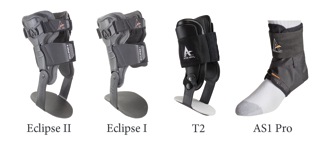Sep 5, 2018Wearing Ankle Braces: Busting Myths & Preventing Repeat Injury
In “jumping” sports, athletes are at a high risk of ankle injury, resulting in time sitting on the bench. Performance Heath’s Dr. Phil Page, Ph.D, PT, ATC, CSCS, FACSM discusses some common myths associated with ankle bracing and injuries and what research tells us about those myths
Myth #1: Ankle braces prevent all ankle injuries.
Some coaches insist their players wear braces to prevent ankle sprains and some players choose to wear them. There are numerous studies that point to the benefits of ankle bracing after the first ankle injury occurs to reduce the incidence of recurrent sprains. That being said, it is OK to wear them if an athlete feels safer doing so without having previously injured their ankle.
“The decision to brace is all about the combination of injury history and risk of future injury,” Dr. Page said. You’re at a higher risk if you’ve previously injured your ankle or if you’re competing in jumping sports (as opposed to running, in which there is a significantly lower risk of ankle injury). The downside to wearing a brace is that you may decrease mobility to gain stability. Is it really worth it for a healthy ankle when your performance might slightly suffer in a low risk sport like jogging? Probably not.
Myth #2: Ankle braces increase the chance of knee injuries.
Research has been done looking at the forces on the knee after landing from a jump. Those researchers hypothesized that if you take away motion in the ankle, you need more at the knee. Because they found that there were additional forces on the knee when the athlete wore ankle bracing, it makes sense that this might predispose athletes to knee injury. However, there have been studies showing that there is no increase of knee injuries when wearing ankle braces.
“There is no proof that wearing an ankle brace will increase lower extremity injury; however, there is the evidence that wearing a brace in a laboratory setting while landing from a jump would change the knee forces. But you can’t automatically say that will cause injuries because there is no data to support that claim,” Dr. Page said.
Myth #3: Wearing ankle braces promotes ankle weakness
This one is pretty straightforward. When strength is tested prior to wearing an ankle brace and after prolonged use of ankle braces, it doesn’t change. “There is a misconception that if you wear a brace you don’t need to use the ankle as much, so people come to the conclusion without evidence that they will lose the strength; however, no studies have proven this.”
Myth #4: Ankle braces decrease performance
Dr. Page has tested this with the Active Ankle Eclipse II brace in several performance studies. “We don’t see any decrease in agility or jumping wearing our Eclipse II ankle brace. Even in some of the smaller studies, we have seen an increase in performance.” Dr. Page attributes this increase to a psychological effect – many may feel invincible wearing the Eclipse II because they do not feel like they will be injured.
 Active Ankle’s mission is to protect and support the ankles of all athletes and they do that by selling a wide range of products. Their fundamental belief is that not all athletes are the same and they aim to provide a best-in-class solution for all. Here are a few player favorites.
Active Ankle’s mission is to protect and support the ankles of all athletes and they do that by selling a wide range of products. Their fundamental belief is that not all athletes are the same and they aim to provide a best-in-class solution for all. Here are a few player favorites.
Eclipse II Dual Upright Ankle Brace. The Eclipse II provides maximum protection available through its solid u-shaped design and multipoint strapping system. It’s ideal for net players that need a higher level of support.
Eclipse I Single Upright Ankle Brace. The Eclipse I provides superior mobility while maintaining the protection of a rigid ankle brace. It’s ideal for backcourt players needing increased side-to-side flexibility for digging and diving.
T2 Rigid Ankle Brace. The T2 is Active Ankle’s best-known rigid ankle brace with its classic and simple design. Recent improvements have strengthened the brace material to be 10 times more durable than previous T2 brace material.
AS1 Pro Lace-Up Brace. The AS1 Pro provides superior protection while maintaining the comfort of a lace-up through its supportive compression and vertical straps that imitate the heel-lock taping technique.
For more information about Active Ankle and the products mentioned, visit www.activeankle.com.



